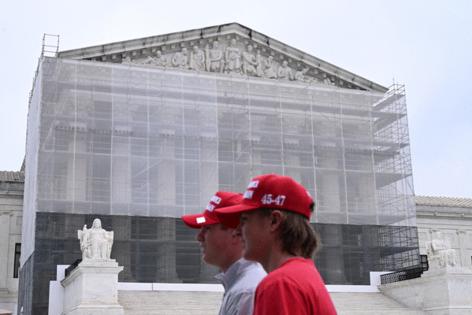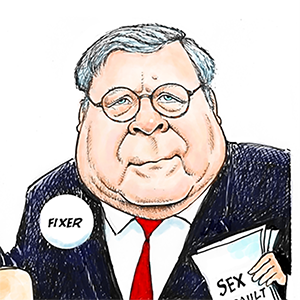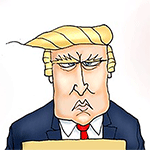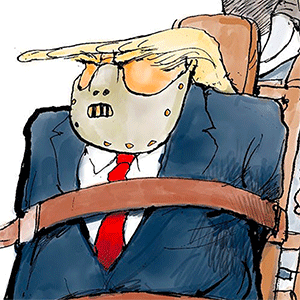Noah Feldman: The Supreme Court's majority is playing the long game
Published in Op Eds
Many legal commentators apparently believe that, in the term that just ended, the Supreme Court further enabled President Donald Trump. The court did, in fact, issue a series of conservative decisions that Trump likes. However, under the leadership of Chief Justice John Roberts, the court also simultaneously pursued a careful strategy aimed at preserving the rule of law in the face of Trump’s unprecedented challenges to it.
The court picked its battles, upholding a meaningful number of lower court orders that blocked unlawful Trump initiatives. At the same time, the justices worked hard to avoid a direct confrontation in which Trump might overtly declare his intention to ignore a court ruling.
Even its most controversial recent decision — ending the Trump-era judicial practice of issuing universal injunctions against presidential action — may be understood as an effort to prevent lower courts from creating a direct conflict with the administration that might lead to a showdown the courts would lose. On this interpretation, Roberts wants to exercise his own careful judgment about when to go toe-to-toe with Trump. His goal is to avoid a constitutional crisis that could undermine the power of the judiciary for generations.
Let me be crystal clear: I disagree strongly with essentially all of the ideologically conservative decisions the court issued this term. (You can read my columns on each of them to see why.) Yet these decisions, wrong though they are, were not the most important element of the Supreme Court’s job since Trump took office.
No, since Jan. 20, 2025, the court’s essential function has been to fight for the preservation of the rule of law. That fight cannot be won simply by bluster, for a very specific constitutional reason: The Supreme Court has no direct enforcement power and no power of the purse. It is, as Alexander Hamilton famously wrote, “the least dangerous branch” — which also means it is the least powerful.
In the end, the Supreme Court has power only because the executive obeys it. If the president defies the courts, the only constitutional remedies available are congressional attempts to withhold funds (which is not going to happen under this Congress) and impeachment (good luck). Maybe — one can only hope — millions of people would go into the streets in defense of the rule of law. Maybe the financial markets would decline sharply. But these are extreme contingencies, and they might not work.
Trump, more than any president before — even Abraham Lincoln in wartime — has shown he is prepared to openly violate the Constitution and the laws of the United States. His attacks on the judiciary, echoed by his vice president, are clearly intended to signal his openness to outright defiance. And in a direct constitutional crisis triggered by defiance of judicial orders, it’s hard to say with confidence that Trump wouldn’t win.
So the job of the court over the last six months has been to hold the line.
It has done so — not resoundingly, but cautiously, as befits judges who aren’t politicians and don’t have a constituency to rely on.
When the lower courts blocked some of the president’s efforts to freeze federal grant money and fire career government employees, the Supreme Court mostly left those orders in place. When District Judge James Boasberg ordered the Trump administration to “facilitate” the return of Kilmar Abrego Garcia, who had been deported to El Salvador without due process, the justices upheld the order — and he is now back in the US, albeit facing new criminal charges. When other detainees slated for deportation sought their day in court, the justices affirmed their due process rights.
Of course, the court’s majority hasn’t stood up to the Trump administration in every instance. Sometimes that has been for technical legal reasons. But it is also because Roberts wants, ideally, to avoid a situation where Trump directly defies a court order.
And if the confrontation must happen, Roberts and the other justices want it to be on an issue where the court’s legal and rhetorical power is at its maximum. That means trying to pick an issue where the law is clearly against Trump; all nine of the justices agree; and no foreign actors outside the court’s jurisdiction are necessary to effectuate the court’s judgment.
The court’s decision ending universal injunctions should be seen as part of this strategy. The practice gained popularity during Trump’s first term as a tool for the courts to block him. It had the advantage of efficiency — once a court ruled a presidential action unlawful, plaintiffs didn’t have to go to multiple courts.
Yet the injunctions turned out to be a double-edged sword, wielded by Trump judicial appointees against Biden administration actions like student debt relief. During the Biden years, liberal lawyers began publicly acknowledging that universal injunctions were a problem in need of fixing. That bipartisan skepticism has now been entirely effaced in the current moment of discussion.
During Trump’s second administration, universal injunctions have revealed another worrisome attribute: They have allowed any district court judge in the country to create a nationwide, direct conflict with the administration. From the perspective of Roberts and the justices, that is like giving battlefield colonels the power to launch a major war. As the senior generals, the justices would prefer to make the tactical and strategic decisions about when to fight the president — the most dangerous adversary they’ve ever faced. Ending universal injunctions gives them that discretion.
Meanwhile, as this judicial calculus is going on, the conservative constitutional revolution is far from over. This term delivered plenty of deeply conservative decisions. These included free speech — in the form of the disastrous TikTok case and the decision permitting age-verification requirements for access to pornography. The court also addressed equal protection — allowing states to bar access to gender-affirming care for teens. And it continued the partial restructuring of the administrative state — a holding in the emergency docket that appears to permit the president to fire even the heads of multimember independent agencies.
These decisions reflect ongoing trends in conservative jurisprudence. They aren’t fundamentally tied to the court’s broader project of preserving the rule of law. A fair assessment of the Supreme Court term should focus not only on these decisions, but also how the court is doing on the most consequential issue: keeping the Constitution alive.
The answer is the court is doing all right. It doesn’t need to win any awards. It just has to do its part in the existential struggle to save democracy and the rule of law.
____
This column reflects the personal views of the author and does not necessarily reflect the opinion of the editorial board or Bloomberg LP and its owners.
Noah Feldman is a Bloomberg Opinion columnist. A professor of law at Harvard University, he is author, most recently, of “To Be a Jew Today: A New Guide to God, Israel, and the Jewish People."
©2025 Bloomberg L.P. Visit bloomberg.com/opinion. Distributed by Tribune Content Agency, LLC.

























































Comments